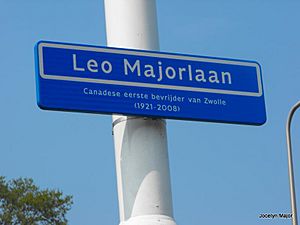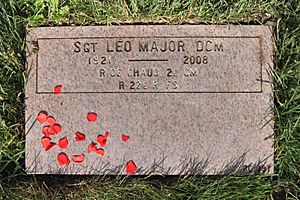Léo Major facts for kids
|
Léo Major
|
|
|---|---|
Quick facts for kids 
Major in 1944
|
|
| Born | January 23, 1921 New Bedford, Massachusetts, U.S. |
| Died | October 12, 2008 (aged 87) Longueuil, Quebec, Canada |
| Buried | |
| Allegiance | Canada |
| Service/ |
Canadian Army |
| Years of service | 1940–1945 1950–1953 |
| Rank | Sergeant |
| Unit | Régiment de la Chaudière Royal 22nd Regiment |
| Battles/wars | World War II
|
| Awards | Distinguished Conduct Medal and bar |
| Spouse(s) |
Pauline De Croiselle
(m. 1951–2008) |
| Children | 4 |
Léo Major (born January 23, 1921 – died October 12, 2008) was a brave Canadian soldier. He was special because he received the Distinguished Conduct Medal (DCM) twice. This medal is given for great bravery in battle. He was the only Canadian soldier to achieve this in two different wars.
Major earned his first DCM in World War II in 1945. This was after a daring mission in Zwolle, a city in the Netherlands. He went to scout the city with a friend. His friend was sadly killed in a firefight. Major continued alone and found the city was mostly empty of German soldiers. Because of his bravery, Zwolle was saved from heavy artillery attacks.
He received his second DCM during the Korean War in 1951. This was for leading his team to capture an important hill. People sometimes called him "the Québécois Rambo" because of his amazing actions.
Contents
A Soldier's Early Life
Léo Major was born on January 23, 1921, in New Bedford, Massachusetts, in the U.S. His parents were French-Canadian. Before his first birthday, his family moved to Montreal, Canada.
When he was 14, Léo went to live with an aunt. He didn't have a good relationship with his father. Also, there wasn't much work available. So, in 1940, Léo joined the Canadian army. He wanted to make his father proud.
World War II Adventures
Léo Major served with the Régiment de la Chaudière. This unit landed on Juno Beach during the Invasion of Normandy on June 6, 1944. This day is also known as D-Day.
During a scouting mission on D-Day, Major captured a German vehicle by himself. This vehicle had important German communication gear and secret codes. A few days later, he met an SS patrol. He fought them and killed four soldiers. However, one soldier threw a phosphorus grenade. Léo lost one eye in the explosion. But he kept fighting! He said he only needed one eye to aim his weapon. He continued his service as a scout and a sniper. He joked that he "looked like a pirate."
Capturing German Soldiers
Léo Major is famous for capturing 93 German soldiers by himself. This happened during the Battle of the Scheldt in the Netherlands. Major and his friend, Corporal Wilfrid Arsenault, were sent to find a missing group of Canadian soldiers. But Arsenault got sick, so Major went alone.
He found the missing soldiers' equipment. He realized they had been captured. Major then entered a house to escape the rain. He saw two German soldiers and captured them. He used them to trick their commanding officer. The officer and about 100 of his men surrendered! Major killed three soldiers who resisted.
Nearby, SS troops saw the surrender. They opened fire on the captured Germans. Seven were killed, and others were hurt. Major ignored the enemy fire. He kept escorting his prisoners to the Canadian front line. He even ordered a Canadian tank to fire on the SS troops. He returned to camp with 93 prisoners.
Major was supposedly chosen for a Distinguished Conduct Medal. But he reportedly refused it. He felt that General Montgomery, who was to give the award, was "incompetent." It's not fully clear if he was nominated or why he didn't get it then. Records only show his later DCM recommendation from 1945.
In February 1945, Major was helping load bodies from a destroyed tank. He jumped into the back of a vehicle. The vehicle hit a land mine. The explosion killed the driver and a chaplain. Major was knocked out. When he woke up, he was taken to a hospital. His back was injured, and it bothered him for years.
Liberating Zwolle City
| Battle of Zwolle | |||||||
|---|---|---|---|---|---|---|---|
| Part of World War II | |||||||
 Leo Majorlaan (Léo Major Avenue) street sign in the Dutch city of Zwolle. The text reads: Canadian first liberator of Zwolle (1921–2008) |
|||||||
|
|||||||
| Belligerents | |||||||
| Commanders and leaders | |||||||
|
Unknown | ||||||
| Units involved | |||||||
| Régiment de la Chaudière | |||||||
| Strength | |||||||
| 2 | 1,500+ | ||||||
| Casualties and losses | |||||||
| 1 | 100+ | ||||||
In April 1945, Major's regiment was near Zwolle, a city with many German soldiers. On April 13, the commanding officer asked for two volunteers. Their mission was to scout the German forces. They also needed to contact the Dutch resistance. This was before the Allies planned to bomb the city.
Private Major and Corporal Arsenault volunteered. They wanted to save Zwolle from being destroyed. So, they decided to try and free the city themselves. That night, they entered a farmhouse. A man named Hendrik van Gerner told them where German soldiers were.
After leaving, Arsenault was killed by German fire. Major became very angry but kept control. He killed two Germans, and the others ran away. Major decided to continue the mission alone. He entered Zwolle near Sassenpoort.
What happened next is a bit unclear. Many stories exist about Major's actions in Zwolle. But here's what we know for sure: Major spent several hours in Zwolle. The German army left the city. Major contacted the Dutch resistance. He returned to camp with Arsenault's body.
Thanks to Major's efforts, the planned bombing of Zwolle was stopped. The next day, the Régiment de la Chaudière entered the city without firing a single shot. For his brave actions, Léo Major received his first Distinguished Conduct Medal.
Stories of His Zwolle Mission
The most popular story says Major attacked Zwolle alone. He used machine guns and grenades. He made lots of noise to trick the Germans. They thought a large Canadian force was attacking. After killing some German soldiers and meeting the resistance, the Germans fled. Major then went back to his camp.
Some versions of the story add more details. They say he took a German driver hostage. Or that he attacked the local SS headquarters.
Another story says Major went to the city center. He captured a German driver outside a tavern. Inside, he found a German officer. Major learned the officer was from a region not loyal to Hitler. Major gave the officer his gun back. He told him the war was almost over. He said he didn't want the city destroyed. Major then spent hours fighting patrols and setting off grenades. He killed four SS members. By 4 AM, the Germans had left. Major signaled the townspeople. He then met the resistance and returned to camp with Arsenault's body.
A different account says Major just walked through empty streets. He contacted the resistance. Then he returned to his regiment to report that the enemy had left.
A museum expert, Dirk Staat, believes many popular stories are myths. He says there's no proof of some events. He thinks Major used a car from the resistance leader, not a hijacked German vehicle. Major himself said he went to the train station first. He made noise with grenades and machine gun fire. He believed this noise scared the Germans into leaving.
Korean War Heroics
After World War II, Major went back to his old job as a pipe fitter. He also had surgery to fix his back, which was hurt in the land mine explosion.
When the Korean War started, Canada sent soldiers to help. Major was called back to duty. He joined the Scout and Sniper Platoon of the 2nd Battalion Royal 22e Régiment. Major fought in the First Battle of Maryang San. Here, he earned a second bar for his Distinguished Conduct Medal. This was for capturing and holding a very important hill in November 1951.
Second Distinguished Conduct Medal
Hill 355, also called Little Gibraltar, was a key location. It overlooked the area for miles around. The Chinese army wanted to take it before peace talks ended the war. The hill was held by the U.S. 3rd Infantry Division. Canadian forces were next to them.
On November 22, the Chinese 64th Army attacked. They had about 40,000 men. Over two days, the Americans were pushed back from Hill 355. The Chinese then moved to nearby Hill 227. This almost surrounded the Canadian forces.
To help, an elite scout and sniper team was called in. It was led by Léo Major. Major and his 18 men wore running shoes to be quiet. They went through enemy lines and crept up Hill 227 from the Chinese side. At a signal, Major's men opened fire. The Chinese were confused. They didn't understand why the attack was coming from inside their lines. By 12:45 AM, Major's team had taken back the hill.
An hour later, the Chinese launched a huge counter-attack. They had about 14,000 men. Major was ordered to retreat, but he refused. He found cover for his men. He held off the enemy all night. The fighting was so close that Major's own mortar bombs were landing near him. His mortar commander said Major was "audacious" and asked for the bombs to fall even closer. Major and his platoon held Hill 227 for three days. Then, the U.S. 3rd Infantry Division came to relieve them.
Death and Legacy
Léo Major passed away in Longueuil, Quebec, on October 12, 2008. He was buried at the Last Post Fund National Field of Honour in Pointe-Claire, Quebec. He was married to Pauline De Croiselle for 57 years. He had four children and five grandchildren.
A documentary film about his amazing adventures, called Léo Major, le fantôme borgne (Léo Major, the one-eyed ghost), was made in Montreal. To celebrate the 75th anniversary of Victory in Europe Day, Canada Post released a stamp in his honor on April 29, 2020.
Honours
| Ribbon | Description | Notes |
| Distinguished Conduct Medal (DCM) | With Bar | |
| 1939–1945 Star | ||
| France and Germany Star | ||
| Defence Medal | ||
| Canadian Volunteer Service Medal | With Overseas Clasp | |
| War Medal | ||
| Korea Medal | ||
| Canadian Volunteer Service Medal for Korea | ||
| United Nations Korea Medal | With "KOREA" Clasp |
- He was given Honorary citizenship of the City of Zwolle, Netherlands, on April 14, 2005.
See also
 In Spanish: Léo Major para niños
In Spanish: Léo Major para niños


